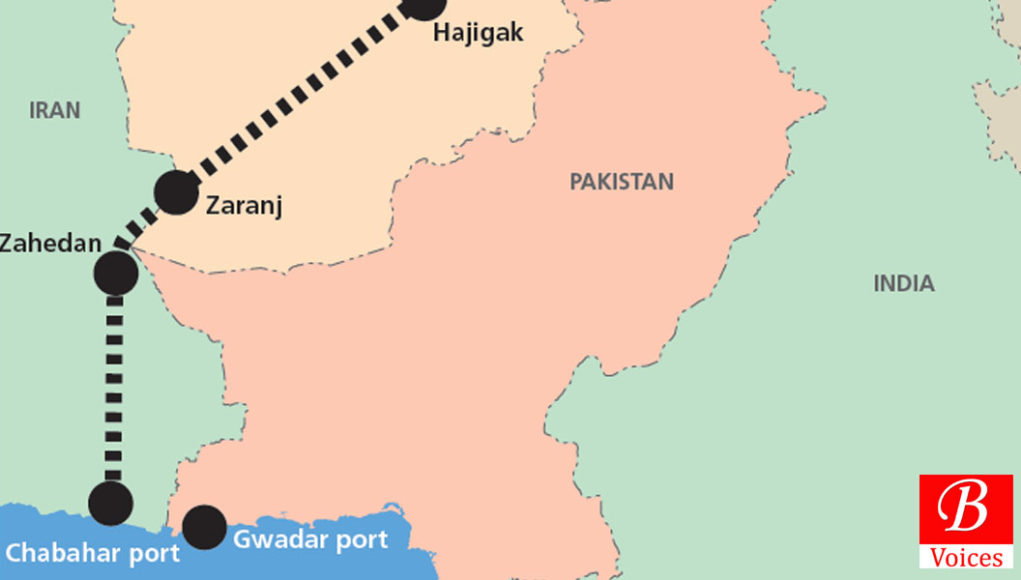Ayaz Ahmed
In the changing dynamics of burgeoning sea trade, Pakistan’s Gwadar Port and Iran’s Chabahar Port would play a significant role in the foreseeable future. Both the ports enjoy exceptional geo-strategic importance due to their close proximity to the Strait of Hormuz region, which holds two-thirds of the world oil reserves. Presumably, once these ports are fully operational, there would be a cut-throat competition between them to dominate the potential regional seaborne trade, albeit the main competitors would be China and India.
China and India – with markedly divergent regional interests – are heavily engaged in the construction and financing of these ports. The Chinese Overseas Port Holding Company (COPHC) took over Gwadar Port in 2013 for 40 years to make it fully operational. In this context, Beijing signed energy and infrastructure deals with Pakistan worth $46 billion, including the one on the development of Gwadar Port. The port opens up a 3,000 km-long trade corridor that will connect Gwadar to Kashgar via roads, railways and pipelines.
Whereas, India has been immersed in substantially financing and constructing Chabahar Port since 2003. On May 6, 2015, it concluded a memorandum of understanding with Iran to complete the development of the port by December 2016. The agreement included an investment of $85.21 million from India to construct a container terminal and a multi-purpose cargo terminal. In New Delhi, Iranian Foreign Minister Javad Zarif offered India a deal to develop the second phase of Chabahar Port and operate it.
Both Iran and India have invested considerably in the development of Chabahar. A 600-kilometer long highway linking Chabahar to Zahidan in Iran’s north – only 240km from Malik on the Iran-Afghanistan border – is already operational. India spent $100 million on building a 220-kilometer Zaranj-Delaram highway in 2009 in the south-western Nimroz province of Afghanistan, which is 700 km away from south-eastern Iran and can be easily extended to link Chabahar. Iran has also commenced construction of a railway line from Chabahar to Zahidan where it connects the Iranian rail network to Central Asia. Recently, Afghanistan also finalised a tripartite trade agreement with Iran and India on using Chabahar Port.
As for Chinese economic interests, China has a hankering for Gwadar Port to import potential Middle Eastern oil and gas, which, according to the BP 2012 Statistical Review of World Energy, possesses 48 percent of the world’s oil and 38 percent of natural gas reserves. Moreover, the Chinese are predisposed to access mineral rich Africa via the same port because it provides the nearest and less expensive route. In return, China will export economic and military related products to the West Asia and Africa.
China’s existing sea route passes through the risky South China Sea, Pacific Rim, the Strait of Malacca and Sri Lanka, and Chinese vessels have to cruise about 10,000 km to reach the trading partners in the region. But Gwadar Port will reduce the sea distance to 2,500 km instead of 10,000 km and land distance for Kashgar to 2,800 because Kashgar is 4,500 km from the port of Shanghai, while Gwadar is 2,800 km from Kashgar. It will not only save time, but also millions of dollars for China.
As far Chinese military interests, China needs Gwadar Port to achieve its strategic objective of becoming an ‘impregnable naval power’ in the Indian Ocean. That will help it check the brewing Indo-US domination of the Arabian Sea, and use the port as an alternate sea route in case India blocks the Strait of Malacca. China would also establish a listening post here chiefly meant to acquire an effectual beachhead for observing the naval manoeuvres of the US in the Persian Gulf and those of India at nearby Indian bases of Gujarat and Mumbai.
Over and above, the communist state also intends to monitor the Sea Lines of Communications (SLOCs) from the Persian Gulf, because about 60 percent of China’s energy requirements come from the Gulf. Moreover, China has also calibrated some long-term policies to control the major oil sea routes and trade links amongst resource-rich regions such as South Asia, Africa, Central Asia, Gulf and the Middle East.
While India needs Chabahar Port to dominate Iran’s crude oil reserves of 157.8 billion barrels and 1,187.3 trillion cubic feet gas reserves. Furthermore, it has crafted some rapacious policies to access and fully utilise $3 trillion’s worth resources of terrorism-riven Afghanistan while hampering China there. In addition, Delhi is set to import energy resources from Central Asia where only Kazakhstan and Turkmenistan possess 3.6 billion barrels of oil and 663.8 trillion cubic feet gas reserves. In return, India has planned to expedite the boom of its struggling economy by exporting cars, computers and information technology related products to Iran, Afghanistan and Central Asia.
Moreover, India will capitalise on Chabahar Port for military purposes because of its apprehension about the Chinese being so close to its naval bases of Gujarat and Mumbai. The Indian government is apprehensive that the Iran-Pakistan gas pipeline project might finally become a reality after the Iran nuclear deal, and the CPEC would greatly assist Pakistan and China to dominate the regional trade via road and rail connections.
Therefore, by relying on Chabahar Port, India would endeavour to encircle Pakistan geo-strategically, and employ all kinds of tricks to systematically sabotage the IP pipeline and the CPEC. With all-out American and Iranian assistance, the Indian agency, RAW, would blatantly fuel and fund Balochistan,s low-intensity insurgency, dormant militancy and rampaging regional terrorism to shed blood in the province.
Since Gwadar Port provides us economic and strategic opportunities, Pakistan should exercise effective leadership by prudently employing its bureaucracy, law-enforcement agencies and diplomacy to safeguard the port and Balochistan from destabilising attacks. More importantly, plausible political, socio-economic and educational reforms should also be introduced in the province.
Writer is a featured columnist for Balochistan Voices
Share your comments!








